Tau emerald
The tau emerald (Hemicordulia tau) is a species of dragonfly in the family Corduliidae.[3] Corduliidae is the only family not a clade within the Infraorder Anisoptera. The species was first described by Edmond de Sélys Longchamps in 1871.[2]
| Tau emerald | |
|---|---|
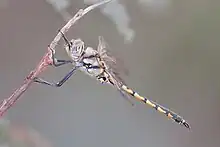 | |
| Male | |
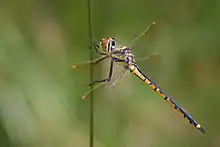 | |
| Female | |
| Scientific classification | |
| Domain: | Eukaryota |
| Kingdom: | Animalia |
| Phylum: | Arthropoda |
| Class: | Insecta |
| Order: | Odonata |
| Infraorder: | Anisoptera |
| Family: | Corduliidae |
| Genus: | Hemicordulia |
| Species: | H. tau |
| Binomial name | |
| Hemicordulia tau | |
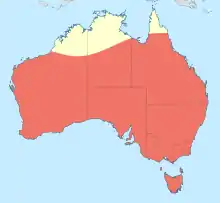 | |
Description
Adult
The tau emerald is a medium-sized, black and yellow dragonfly with long legs,[4] reaching a body length of about 50 mm.[5] As is unique to dragonfly and mayfly species, H. tau has flight muscles attached directly to the wings,[6] and in both the males and females the inboard edge of the hindwing is rounded.[4] The 7th abdominal tergum is extensively black above and yellowish at the sides.[7] The top of the frons are yellow with a dark T-mark.[8] The species exhibits a linear relationship between head width and body length. [9]
Nearly all of the dragonfly's head is eye, allowing incredible vision that encompasses almost every angle except right behind them.[10] H. tau has a particularly large and well developed compound eye with two principal regions, the dorsal eye and the ventral eye.[11] The dorsal eye is principally sensitive to short wavelength light, while the ventral eye has 3 or more spectral types of photoreceptors.[11]
Larval stages
The length of time each larval stage of H. tau requires can decrease as the temperature of the water it inhabits increases.[9] It is capable of completing its life cycle from egg to adult in less than 6 weeks.[12] Nymphs reach a total length of 22–24 mm. No mid-dorsal abdominal spines are present unlike other Hemicordulia, but humps may be present on segments 4–9 and the lateral spines are very small.[13] The nymphs have a ladle-shaped labium with premental and palpal setae, and well-developed palpal dentations bearing groups of setae. The prementum has a distinct ventro-basal midline/groove.[8]
An analysis of head width frequencies of samples from Lake Eucumbene suggest there is at least 9 instars in the life history of H. tau, however the number of larval instars is known to vary between, and within, Odonata species.[9]
Ecology
H. tau is found in all parts of Australia except northern Queensland and north-western Western Australia[8] and is one of Australia's most abundant dragonflies.[9] It is considered a dry-country dragon fly, often inhabiting the arid Australian inland.[14] The adults are vagrants[8] and highly opportunistic users of habitat for breeding.[9]
In addition to rivers, lakes and swamps[8] H. tau has the ability to breed in temporary waters due to its short larval stages.[15] Nymph have a high thermal growth coefficient and details of its life history may vary with their location.[9] The nymph are able to tolerate the high temperatures found in temporary shallow ponds.[9] The ability of H. tau to utilize temporary waters and reduce its larval life with increase in temperature contribute to its abundance and wide distribution.[9] They are also able to overwinter in cold permanent refuges,[9] and have been observed in water with a salinity between 7.8g/L to 13.9g/L.[16]
H. tau larva, similar to other Odonata species, are associated with clean water and it has been suggested they could be monitored to detect changes in water quality.[14][4] Larval habitat is typically leaf litter and weeds.[9] Many aquatic invertebrates with terrestrial adult stages require a snag extending above the water surface for emergence to the adult stage.[17]
Conservation status
The tau emerald is listed as least concern under the International Union for Conservation of Nature and Natural Resources (IUCN) red list of threatened species.[19] Population trend is classified as unknown and no conservation actions are recommended.
Gallery
.jpg.webp) Tau Emerald Dragonfly
Tau Emerald Dragonfly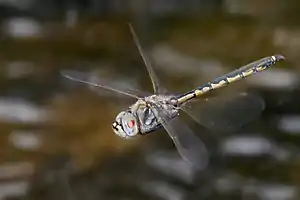 Male in flight
Male in flight.jpg.webp) Female
Female.jpg.webp) Female
Female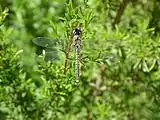 Male
Male Mating pair
Mating pair.jpg.webp) Female wings
Female wings.jpg.webp) Male wings
Male wings.jpg.webp) Hemicordulia tau
Hemicordulia tau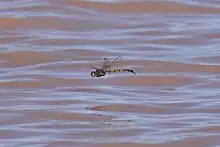 Hemicordulia tau in flight
Hemicordulia tau in flight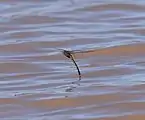 Hemicordulia tau dipping tail
Hemicordulia tau dipping tail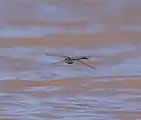 Hemicordulia tau
Hemicordulia tau
References
- Dow, R.A. (2017). "IUCN Red List of Threatened Species: Hemicordulia tau". IUCN Red List of Threatened Species. Retrieved 2021-06-16.
- Selys-Longchamps, Edmond (1871). "Synopsis des Cordulines". Bulletin de la Classe des Science, Académie Royale de Belgique. 2 (in French). 31: 256 – via Biodiversity Heritage Library.
- "Species Hemicordulia tau (Selys, 1871)". Australian Faunal Directory. Australian Biological Resources Study. 2012. Retrieved 28 January 2017.
- Watson, J.A.L.; Theischinger, G.; Abbey, H.M. (1991). The Australian Dragonflies: A Guide to the Identification, Distributions and Habitats of Australian Odonata. Melbourne: CSIRO. ISBN 0643051368.
- "Tau Emerald Dragonfly - Hemicordulia tau". www.brisbaneinsects.com. Retrieved 2021-06-17.
- Devi, M.; Indirakumar, K. (2020). "Why Insects are Dominance in the Biosphere?". Biotica Research Today. 2 (11): 1174–1178. ISSN 2582-6654.
- Theischinger, G., Endersby, I. (2009). Identification guide to the Australian Odonata. Dept. of Environment, Climate Change and Water. ISBN 978-1-74232-475-3. OCLC 535321248.
{{cite book}}: CS1 maint: multiple names: authors list (link) - Günther Theischinger and John Hawking (2006). The Complete Field Guide To Dragonflies Of Australia. Collingwood, Victoria: CSIRO Publishing. p. 249.
- Faragher, R. A. (1980). "Life Cycle of Hemicordulia Tau Selys (odonata: Corduliidae) in Lake Eucumbene, N.S.W., with Notes on Predation on It by Two Trout Species". Australian Journal of Entomology. 19 (4): 269–276. doi:10.1111/j.1440-6055.1980.tb00985.x. ISSN 1440-6055.
- Zielinski, Sarah. "14 Fun Facts About Dragonflies". Smithsonian Magazine. Retrieved 2021-06-14.
- Yang, E.C.; Osorio, D. (1996). "Spectral responses and chromatic processing in the dragonfly lamina". Journal of Comparative Physiology A. 178 (4). doi:10.1007/BF00190184. ISSN 0340-7594. S2CID 24838606.
- "Odonata | What Bug Is That?". anic.ento.csiro.au. Retrieved 2021-06-17.
- Theischinger, G. (2006). The complete field guide to dragonflies of Australia. John Hawking. Collingwood, Vic. ISBN 978-1-4863-1375-4. OCLC 1252724816.
{{cite book}}: CS1 maint: location missing publisher (link) - Watson, J.A.L. (1982). "Dragonflies in the Australian environment: taxonomy, biology and conservation". Advances in Odonatology. 1 (1): 293–302. ISSN 0168-0161.
- Hodgkin, E. P.; Watson, J.A.L. (1958). "Breeding of Dragonflies in Temporary Waters". Nature. 181 (4614): 1015–1016. Bibcode:1958Natur.181.1015H. doi:10.1038/1811015b0. ISSN 1476-4687. S2CID 4272949.
- Rutherford, J.C.; Kefford, B.J. (2005). "Effects of salinity on stream ecosystems: improving models for macroinvertebrates". CSIRO Land and Water Technical Report. doi:10.4225/08/58597507b8552. Retrieved 2021-06-14.
{{cite journal}}: CS1 maint: date and year (link) - Davies, Peter (1998). "Large woody debris are important habitat in rivers" (PDF). Western Wildlife. 2: 14–15 – via Wetland Research.
- Lenz, Michael (2018). "Mass Emergence of Dragonflies Attract Large Numbers of White-Faced Herons" (PDF). Canberra Bird Notes. 43: 290–293 – via Canberra Ornithologists Group.
- Dow, R.A. (2017). "IUCN Red List of Threatened Species: Hemicordulia tau". IUCN Red List of Threatened Species. Retrieved 2021-06-16.
